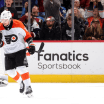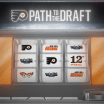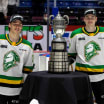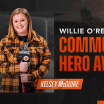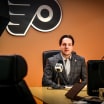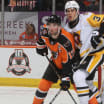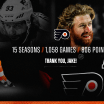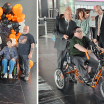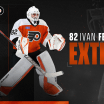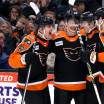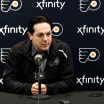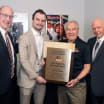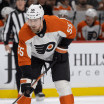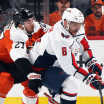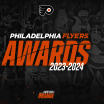March 23 is the final Throwback Thursday of the 2022-23 season: All Decades Night. After previously going decade-by-decade during the Throwback Thursday series, All Decades Night will recall memorable moments and key figures across the gamut of team history.
Throwback Thursday: The First Flyers Fans
March 23 is the final Throwback Thursday of the 2022-23 season: All Decades Night
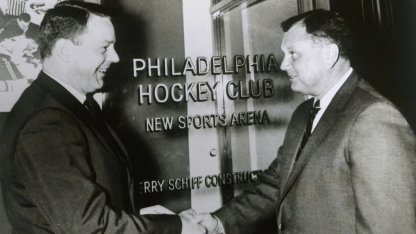
For the final Throwback Thursday tie-in article, PhiladelphiaFlyers.com will honor the people who truly have made it all possible: the Flyers fans themselves.
A history-shaping event in the earliest days of the franchise was the formation of the Flyers Fan Club in 1966-77. It's a story that unfolded before the NHL organization ever played a single game, had any players on the roster or even had an official team name.
The history of professional hockey in Philadelphia was not a happy one before the National Hockey League granted an as-yet-unnamed expansion franchise to Philadelphia Hockey Club, Inc. on February 9, 1966. It was not without some justification that The Hockey News declared the Philadelphia franchise the least likely to succeed among the six new teams in the NHL.
The previous NHL team in Philadelphia, the Quakers, were a disaster on the ice and at the gate during its lone season of existence (1930-31). Philadelphia also had a succession of American Hockey League and independent lower minor league teams - each and every one from 1929 to 1947 coached by Hockey Hall of Famer Herb Gardiner - that came and went over the years.
There were clubs called the Arrows, the Falcons, the Rockets and two different incarnations of the Ramblers. The teams played their home games in the ramshackle Philadelphia Arena located at 46th and Market St. in west Philadelphia.
Ramblers Rooters Lose Their Team
A second incarnation of Ramblers, played in the Eastern Hockey League from 1955 to 1964. They were never especially successful but they did have some entertaining players. One of its more notable alumni was defenseman Ted Harris, who went on to win four Stanley Cup championships with the Montreal Canadiens and one with the Philadelphia Flyers (1974-75).
The fan base for the Ramblers was not very big but it was fiercely loyal. Proudly sporting red and white membership buttons, the "Ramblers Rooters" club was devoted not only to the team itself but to its players. At the games, the Rooters boisterously supported the home side and made sure the visiting team - and the referee - knew their feelings about each and every goal, check, save and penalty call. They hooted, hollered, chanted and stomped their feet in the rickety Arena stands. Sometimes, a few Rooters even came equipped with bullhorns and sirens to get their point across.
Off the ice, the Rooters drew close to many of the Ramblers' players, throwing parties for the team, babysitting for their children, assisting players in lining up local offseason jobs (a necessity for players to make ends meet in that era) and giving the players an end-of-season thank you gift.
After the Ramblers owners clashed and dissolved the team, the players were drafted by other Eastern League clubs or signed with American Hockey League teams. The remaining management then relocated to Cherry Hill, NJ and created the Jersey Devils (not to be confused with the current NHL team based in northern New Jersey, which traces its origins to the NHL's Kansas City Scouts and Colorado Rockies franchise).
The Ramblers Rooters did not simply transfer their loyalties to the Devils. Instead, for the next several years, the remaining members longed for a new Philadelphia team to love.
Fan club president Lou Damia, a Collingale resident who worked at the General Electric Co. plant at 69th Street and Elmwood Avenue in Philadelphia, spoke out passionately to whomever would listen that Philadelphia deserved a new team; even one in the NHL.
"There is no reason why a city the size of Philadelphia couldn't have a team," Damia told the Delaware County Times on April 27, 1965.
"Ice hockey is one of the best spectator sports there is, and given the proper promotion there'd be no problem supporting a team in Philadelphia. There Is a solid nucleus of good hockey fans in the Philadelphia area. Getting additional fans is a matter of promotion. Once people come out to a game, they usually want to come back because it gets be like a contagious disease."
Damia went on to tell the newspaper that he and other officers of the Ramblers Rooters were working on putting together a promotional pledge packet to get people to say they would buy tickets to see a new Philadelphia professional hockey club.
There was also a written petition drive to get signatures to the verbal pledges. The hope was to use the support pledges as a means of getting potential team owners interested in starting a venture.
The Rooters first tried to enlist owners of previous Philadelphia hockey teams but the responses were all "thanks but no thanks." Undaunted, Damia and John Wagner went to former player-coach Doug Adam to scour his hockey and business contacts.
Damia expressed optimism to the newspaper that progress was being made.
"Right now, I would say it's only a matter of time before we find somebody willing to invest and bring a team back," he told reporter Rich Wetlcoli.
In reality, the grassroots campaign was going nowhere in a hurry. The Ramblers Rooters members who kept the faith subsisted on the hope that some prospective owner shared the same vision they had of a successful and well-supported team in Philadelphia.
"We're just trying to get an Ice -hockey team back," Damia said to the newspaper. "The main thing is to get enough fans to say they'll come out for as many or as few games as they want. Once they come out, the game will hold them and they'll keep coming out. Anybody who's Interested should contact me."
A Team Needs a Fan Base
Ed Snider and the Rooters were unaware of one another as they each went about their quests to bring NHL hockey to Philadelphia.
Originally hailing from Washington, Snider became a Philadelphia Eagles executive before co-founding what became the Flyers. He undertook massive risk of financial ruin based mostly on a gut feeling that Philadelphia would get behind a hockey team once it was exposed to the sport. He had not researched the dubious history of hockey franchises in the city, although the partners in Philadelphia Hockey Club, Inc. certainly heard about it from the NHL expansion committee as the Philadelphia group made what initially considered a dark horse bid for a franchise.
By necessity, the Philadelphia bidders kept a low profile as they went about trying to secure a land deal for a new arena and to convince the NHL to award a team. This was done to avoid spurring competitors that could sink the project financially before it ever got off the ground.
There was virtually no publicity around the efforts of Snider and his partners. The Ramblers Rooters knew little to nothing of their efforts, nor was the grassroots campaign on the investors' radar screen with so many other hurdles to clear first before drumming up ticket sales could even be a consideration. They had to establish a franchise first, and then make sure there would be an arena built in which to play. Simultaneous to building fan interest here had to be a hockey operations staff put in place to hire a coach and prepare to create a roster.
The franchise that would soon become known as the Flyers established its first modest business office on the ground floor at the Life of Pennsylvania building, located at 15th and Locust Streets in Center City.
From a publicity standpoint, things were very quiet - almost frighteningly so - in the early weeks after news broke that the NHL had given a conditional franchise to Philadelphia. The newspapers were not calling for updates. The phones barely rang for information requests from fans and potential sponsors.
On a slow day in March of 1966, there was a knock on the office door. Lou Scheinfeld answered. A former Philadelphia Daily News reporter, Scheinfeld had been hired by Snider as a vice president of the arena project in charge of public relations and marketing after impressing Snider with his sharp mind and enthusiastic personality.
Lou Damia and John Wagner stood on the other side of the door as Scheinfeld warmly invited them to come inside. The team office was hardly bustling with activity yet. There was plenty of time to greet visitors.
The Ramblers Rooters holdovers pledged their full support to the new team, promising to enlist as many people as possible and come aboard. On that day, the remnants of Ramblers Rooters turned into the foundation for the Flyers Fan Club (although it would not be until August 3, 1966 that the new team's name was announced after a Name-the-Team contest in July).
"I couldn't believe it when they showed up," Scheinfeld recalled in Jay Greenberg's Full Spectrum, "because 'apathy' was too weak a word to describe how people were looking at us."
Later that year, when ticket sales for 1967-68 began on Nov. 29 at the Flyers' office at 15th and Locust, the charter members of the Flyers Fan Club became the first to fill out applications. The very first person to sign his name was Herb Gardiner.
Each one had to offer exactly what the other longed to obtain. The fan club needed a hockey team to support. Now that Philadelphia Hockey Club, Inc. had a conditional franchise, it needed to find a fan base to care about it and to generate some word-of-mouth enthusiasm as well as some early-bird ticket sales.
It did not take the rest of Philadelphia long to realize what men like Ed Snider and Lou Damia knew years earlier: hockey was too good of a sport not to succeed in Philadelphia if it had the proper introduction to the game and an NHL franchise to support.
Meanwhile, the official Flyers Fan Club still exists to this day. It remains an esteemed part of the fan base; one to which the late Ed Snider said many times over the years he appreciated for its undying loyalty more than even the people involved in the beginning could have ever known.
Lou Damia and Flyers Fan Club vice president, Guy Paul, are now deceased, but left a legacy that has lasted for 57 years and counting. They were instrumental in the changeover from the Ramblers fan club to the Flyers Fan Club and, in many ways, were the first diehard fans of the Philadelphia Flyers.

